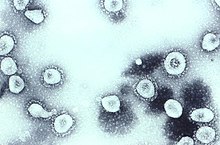Human coronavirus OC43
| Human coronavirus OC43 (HCoV-OC43) | |
|---|---|
 Transmissions-elektronmikroskopi af HCoV-OC43 | |
| Videnskabelig klassifikation | |
| Domæne | Riboviria |
| Rige | Orthornavirae |
| Række | Pisuviricota |
| Klasse | Pisoniviricetes |
| Orden | Nidovirales |
| Familie | Coronaviridae |
| Slægt | Betacoronavirus |
| Art | Betacoronavirus 1 |
| Stamme | Human coronavirus OC43 |
| Hjælp til læsning af taksobokse | |
Human coronavirus OC43[1] (HCoV-OC43) tilhører arten Betacoronavirus 1 i slægten Betacoronavirus; den kan inficere mennesker og kvæg.[2][3] Den inficerende coronavirus er en indkapslet, enkeltstrenget (single-stranded) RNA-virus med positiv sense, der kommer ind i værtscellen ved at binde til receptoren 'N-acetyl-9-O-acetylneuraminsyre'.[4]
OC43 er en af syv kendte coronavirus der kan inficere mennesker: HCoV-229E, HCoV-NL63, HCoV-HKU1, MERS-CoV, den originale SARS-CoV (eller SARS-CoV-1) og SARS-CoV-2. Sammen med HCoV-229E og HCoV-NL63 (medlemmer af Alphacoronavirus-slægten) og Betacoronavirus HCoV-HKU1, er det en af de virus der er ansvarlige for forkølelse.[5][6] Virusset har − som andre coronavirus fra slægten Betacoronavirus, subgenus Embecovirus − yderligere et kortere peplomer eller 'spike-protein' (S) [note 1] Hemagglutinin esterase (HE).[7][2]
Analyse af det molekylære ur mellem menneskets OC43-virus og koens coronavirus (BCoV) viser et påfaldende årstalssammenfald for virussernes seneste fælles stamfar og 1889-1890-pandemien.[8] Den pandemi har ellers har været forklaret som en influenza-pandemi.
Noter og referencer
- Noter
- ^ peplomer / spike-protein : Vedr. strukturproteiner, se evt. Coronavirus#Proteiner hvor de nævnes : "Spike (S) (også benævnt peplomer) er overfladeprotein og glycoprotein på 1255-1282 aminosyrer, der danner trimerer og bestemmer værtsspecifiteten og infektiviteten, idet det reagerer med værtens cellulære receptor, ..."
- Referencer
- ^ Lee, Paul. Molecular epidemiology of human coronavirus OC43 in Hong Kong (Afhandling). The University of Hong Kong Libraries. doi:10.5353/th_b4501128. hdl:10722/131538.
- ^ a b "Taxonomy browser (Betacoronavirus 1)". www.ncbi.nlm.nih.gov. Hentet 2020-02-29.
- ^ Lim, Yvonne Xinyi; Ng, Yan Ling; Tam, James P.; Liu, Ding Xiang (2016-07-25). "Human Coronaviruses: A Review of Virus–Host Interactions". Diseases. 4 (3): 26. doi:10.3390/diseases4030026. PMC 5456285. PMID 28933406.
See Table 1.
- ^ Li, Fang (2016-09-29). "Structure, Function, and Evolution of Coronavirus Spike Proteins". Annual Review of Virology. 3 (1): 237-261. doi:10.1146/annurev-virology-110615-042301. PMC 5457962. PMID 27578435.
BCoV S1-NTD does not recognize galactose as galectins do. Instead, it recognizes 5-N-acetyl-9-O-acetylneuraminic acid (Neu5,9Ac2) (30, 43). The same sugar receptor is also recognized by human coronavirus OC43 (43, 99). OC43 and BCoV are closely related genetically, and OC43 might have resulted from zoonotic spillover of BCoV (100, 101).
- ^ Lau, Susanna K. P.; Lee, Paul; Tsang, Alan K. L.; Yip, Cyril C. Y.; Tse, Herman; Lee, Rodney A.; So, Lok-Yee; Lau, Y.-L.; Chan, Kwok-Hung; Woo, Patrick C. Y.; Yuen, Kwok-Yung (2011). "Molecular Epidemiology of Human Coronavirus OC43 Reveals Evolution of Different Genotypes over Time and Recent Emergence of a Novel Genotype due to Natural Recombination". Journal of Virology. 85 (21): 11325-37. doi:10.1128/JVI.05512-11. PMC 3194943. PMID 21849456.
- ^ Gaunt, E.R.; Hardie, A.; Claas, E.C.J.; Simmonds, P.; Templeton, K.E. (2010). "Epidemiology and clinical presentations of the four human coronaviruses 229E, HKU1, NL63, and OC43 detected over 3 years using a novel multiplex real-time PCR method". J Clin Microbiol. 48 (8): 2940-7. doi:10.1128/JCM.00636-10. PMC 2916580. PMID 20554810.
- ^ Woo, Patrick C. Y.; Huang, Yi; Lau, Susanna K. P.; Yuen, Kwok-Yung (2010-08-24). "Coronavirus Genomics and Bioinformatics Analysis". Viruses. 2 (8): 1804-20. doi:10.3390/v2081803. PMC 3185738. PMID 21994708.
In all members of Betacoronavirus subgroup A, a haemagglutinin esterase (HE) gene, which encodes a glycoprotein with neuraminate O-acetyl-esterase activity and the active site FGDS, is present downstream to ORF1ab and upstream to S gene (Figure 1).
- ^ Leen Vijgen; Els Keyaerts; Elien Moës; Inge Thoelen; Elke Wollants; Philippe Lemey; Anne-Mieke Vandamme; Marc Van Ranst (1. februar 2005), "Complete genomic sequence of human coronavirus OC43: molecular clock analysis suggests a relatively recent zoonotic coronavirus transmission event", Journal of Virology, 79 (3): 1595-1604, doi:10.1128/JVI.79.3.1595-1604.2005, PMC 544107, PMID 15650185, Wikidata Q33717322
Se også
Eksterne henvisninger
 Wikispecies har taksonomi med forbindelse til Human coronavirus OC43
Wikispecies har taksonomi med forbindelse til Human coronavirus OC43- "Coronaviruses" fra Micro.msb.le.ac.uk
- "Betacoronavirus" fra Viralzone.expasy.org
- 'Taxon identifiers'. Engelsk hjælpeside til 'taksonindentifikatorer'
| Spire Denne artikel om biologi er en spire som bør udbygges. Du er velkommen til at hjælpe Wikipedia ved at udvide den. |
Medier brugt på denne side
This illustration, created at the Centers for Disease Control and Prevention (CDC), reveals ultrastructural morphology exhibited by coronaviruses. Note the spikes that adorn the outer surface of the virus, which impart the look of a corona surrounding the virion, when viewed electron microscopically. A novel coronavirus, named Severe Acute Respiratory Syndrome coronavirus 2 (SARS-CoV-2), was identified as the cause of an outbreak of respiratory illness first detected in Wuhan, China in 2019. The illness caused by this virus has been named coronavirus disease 2019 (COVID-19).
Forfatter/Opretter: Emmanuel Boutet, Licens: CC BY-SA 2.5
A black bee (Apis mellifera mellifera.
This 1981 transmission electron microscopic (TEM) image revealed the presence of numbers of coronavirus OC43 virions.



